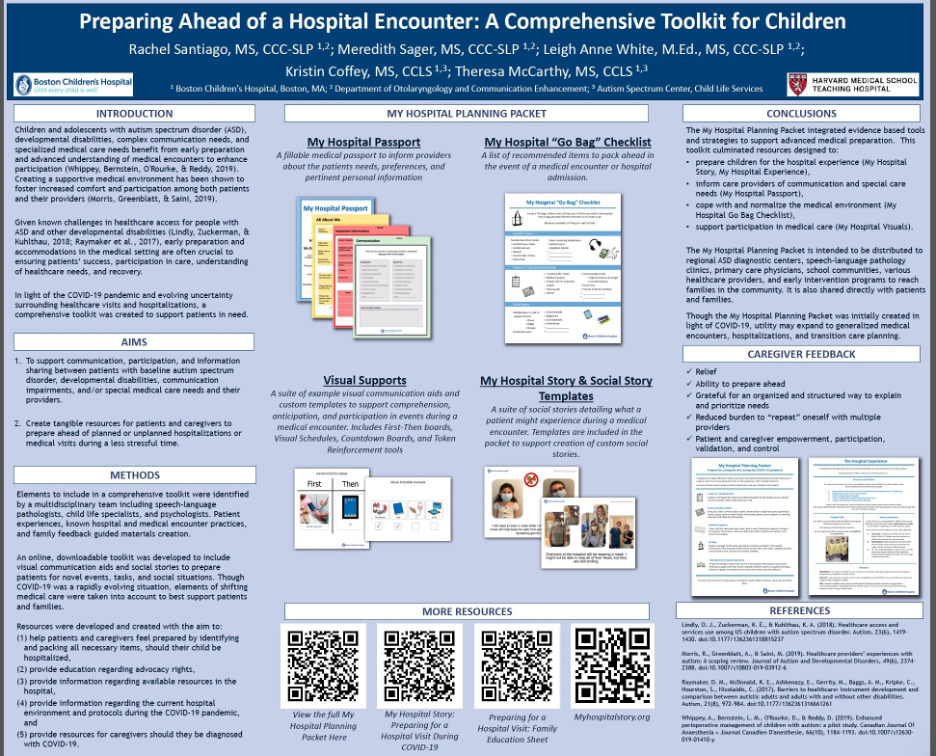Research & Innovation | Overview
The Inpatient Augmentative Communication Program has a rich history in program development and enhancement, research and education, and innovation. Our team collaborates with providers across Boston Children’s Hospital, the nation, and the world to inform and enrich patient-provider communication practices and communication access needs in healthcare.
My Hospital Planning packet
In March 2020, with a rise in COVID-19 cases across the United States and the start of the global pandemic, our inpatient and outpatient speech-language pathologists mobilized efforts to create preparatory materials for patients requiring hospital care. Along with Child Life specialists in the Autism Spectrum Center and the ASC’s Family Advisory Committee, the My Hospital Planning Packet was created. The packet includes information related to hospital practices during the pandemic, “go bag” packing recommendations, a communication passport template, and visual communication aid templates (e.g. token reinforcement boards, social stories, and countdown schedules). The team also created various My Hospital Stories to support children’s understanding of upcoming hospital visits and COVID-19 testing, including the following topics:

In November 2020, our ACP and Child Life colleagues were recognized by the American Speech Language and Hearing Association with a Meritorious Poster Submission certificate award for “Preparing for a Hospital Encounter During the COVID-19 Pandemic: A Comprehensive Toolkit for Children.”
Global impact
Members of our team support local, national, and international efforts to educate, inform, and impact bedside communication enhancement practices. This includes mentorship and collaborative relationships with hospitals in Boston, across the nation; and internationally, presentations and workshops at conferences and participation in the Patient Provider Communication Network. Through this collaborative work, we aim to support research, innovations, and discussions to promote patient-provider communication between patients who have communication vulnerabilities and their providers ahead of or during healthcare encounters.
Setting standards of care
In 2009, Boston Children's Augmentative Communication Program was invited to join The Joint Commission in developing nationwide standards of care for patients who are communication vulnerable. In partnership with The Joint Commission, John M. Costello, MA, the director of Boston Children's Augmentative Communication Program, participated in a 2009 webinar, "Call to Action: Improving Care to Communication Vulnerable Patients.” We are pleased to have been part of the large multidisciplinary national committee that helped launch the 2010 Joint Commission Standard for Advancing Effective Communication, Cultural Competence, and Family Centered Care.
Hospital-based picture communication board
In 2002 the Boston Children's Hospital Medical Symbol Set was created to better support the communication needs of patients by representing unique vocabulary related to hospitalization. Because the dedicated augmentative communication service Boston Children's offers is extremely unique, in 2008 the creator of the Vidatak EZ Board teamed with Children's to create the Vidatak Picture Communication Board.
Through this collaboration, the Boston Children's Hospital Medical Symbol Set is available to patients whose medical provider does not have the ability or dedicated staff available to create custom communication boards.
For more information, visit www.vidatak.com.
Publications
(Bolded authors are employees in the Department of Otolaryngology and Center for Communication Enhancement at Boston Children’s Hospital.)
- Santiago, R., Altschuler, T., Gormley, J., Howard, M., Pressman, H., & Blackstone, S. (2021). Promoting System Change for Communication Access in Acute Care Hospitals. Assistive Technology Outcomes & Benefits, 15, pp 100-118
- Hurtig, R., Alper, R., Altschuler, T., Gendreau, S., Gormley, J., Marshall, S., Santiago, R., Scibilia, S. (2020). Improving Outcomes for Hospitalized Patients Pre- and Post-COVID-19. Perspectives of the ASHA Special Interest Groups. doi:10.1044/2020_PERSP-20-00144
- McKeon, M., Kohn, J., Munhall, D., Wells, S., Blanchette, S., Santiago, R., Graham, R., Nuss, R., Rahbar, R., Volk, M., Watters, K. (2019). Association of a Multidisciplinary Care Approach With the Quality of Care After Pediatric Tracheostomy. JAMA Otolaryngology–Head & Neck Surgery, 145(11), 1035-1042. doi:10.1001/jamaoto.2019.2500
- Santiago, R., Howard, M., Dombrowski, N. D., Watters, K., Volk, M. S., Nuss, R., Costello, J. M., Rahbar, R. (2019). Preoperative augmentative and alternative communication enhancement in pediatric tracheostomy. Laryngoscope. doi:10.1002/lary.28288
- Costello, J. M., Santiago, R., & Blackstone, S. (2015). Pediatric Acute and Intensive Care in Hospitals. In Blackstone, Beukelman, & Yorkston (Eds.), Patient-Provider Communication: Roles for Speech-Language Pathologists and Other Health Care Professionals: Pleural Publishing.
- Santiago, R. & Costello, J. M. (2013). AAC Assessment and Intervention in Pediatric ICU/Acute Care: From Referral through Continuum of Care. SIG 12 Perspectives on Augmentative and Alternative Communication, 22(2), 102-111. doi:10.1044/aac22.2.102
- Costello, J. M., Patak, L., & Pritchard, J. (2010). Communication vulnerable patients in the pediatric ICU: Enhancing care through augmentative and alternative communication. J Pediatr Rehabil Med, 3(4), 289-301. doi:10.3233/PRM-2010-0140
- Patak, L., Wilson-Stronks, A., Costello, J., Kleinpell, R. M., Henneman, E. A., Person, C., & Happ, M. B. (2009). Improving patient-provider communication: a call to action. J Nurs Adm, 39(9), 372-376. doi:10.1097/NNA.0b013e3181b414ca
- Costello, J. (2009, December 1, 2009). Last Words, Last Connections: How Augmentative Communication Can Support Children Facing End of Life. The ASHA Leader, 13(16).
- Costello, J. (2000). AAC intervention in the intensive care unit: The Children's Hospital Boston model. Augmentative and Alternative Communication, 16(3), 137-153. doi:10.1080/07434610012331279004
